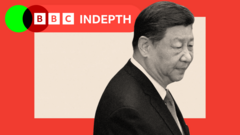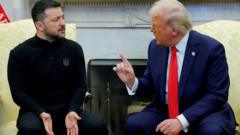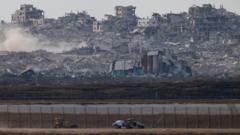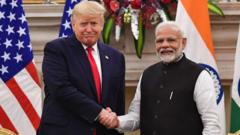The domestic market faces serious challenges, with consumers hesitant to spend amid economic uncertainty, while Xi aims to navigate tribulations and explore new markets in the wake of U.S. tariffs.
**Xi's Endurance Against Trump's Economic Maneuvers: A Crucial Test**

**Xi's Endurance Against Trump's Economic Maneuvers: A Crucial Test**
As tariffs rise, can President Xi Jinping transform challenges into opportunities for China's economy?
In a landscape where the name Donald Trump elicits chuckles rather than fear among Chinese traders, it's evident that U.S. tariffs are far from paralyzing China. Instead, they have sparked a wave of humorous memes and viral videos, fueled by online nationalists who leverage the humor of key political figures. President Xi Jinping expressed confidence in China’s ability to tackle these external pressures by highlighting the nation’s historical ethos of self-reliance and resilience. He remarked, "For over 70 years, China has always relied on self-reliance and hard work for development… unafraid of any unreasonable suppression," a sentiment reflecting both ambition and the current reality of his administration's challenges.
While Xi's confidence stems from a strengthened domestic economy that is seemingly less reliant on U.S. exports than in previous decades, the pressures inflicted by Trump's tariff strategy coincide with China's existing struggles, including a faltering housing market, soaring unemployment, and general consumer caution. For the vast population of 1.4 billion, the dream of economic rejuvenation that Xi has promoted now faces rigorous trials. With a lack of consumer confidence shaking the foundation of spending, the question arises: can Xi translate the economic barriers posed by U.S. tariffs into opportunities for growth?
Challenges abound. The housing crisis, where previously robust investments are trapped in depreciating property values, looms large, compounded by the staggering number of vacant homes that have led to the phenomenon of "ghost cities." This real estate collapse has pressured consumer spending as families grapple with lost savings, leading many to adopt a more cautious financial approach.
Moreover, economic anxiety extends to the younger generation, a demographic grappling with uncertain job prospects as youth unemployment has skyrocketed. With fears surrounding outdated pension systems looming, it becomes even more vital for Xi's government to inject renewed vigor into economic initiatives and address the growing discontent among the populace.
As Xi seeks to champion domestic demand as a counterbalance to reduced exports, the government has embarked on a series of financial relief programs, including childcare subsidies and consumer discounts. Nevertheless, economists stress that these quick fixes lack sustainability and that a more profound overhaul of income growth for residents is essential for enduring economic recovery.
Politically, Xi's leadership stands at a precipice, with civil discontent threatening to stir unrest amid a growing chorus of protests centered around economic grievances. The external pressure from Trump's tariffs adds another layer of urgency as Xi attempts to maintain stability and retain the trust of his citizens.
Alternatively, Xi has turned outward, seeking to expand trade relations with nations in Southeast Asia and elsewhere, building connections that could buffer the potential fallout from reduced U.S. exports. With a strategic pivot to the Global South, China has secured its place as a reliable partner for many countries, countering the isolationist tendencies of U.S. trade policies.
However, the success of this approach is not without its pitfalls; there are concerns over the implications of exporting excess supply to smaller markets and potential trade frictions as a result. The complexities of international trade necessitate a careful strategy moving forward for Xi.
Nonetheless, there are signs of potential shifts in the U.S.-China trade relationship, as hinted by Trump's recent rhetoric. With social media buzzing about perceived backtrackings, the outcome of any negotiations remains to be seen. As China reflects on its strategies, its ability to adapt and implement internal reforms will ultimately dictate its resilience against both external tariffs and domestic pressures. In the grand game of economic chess, Xi seeks to not merely withstand the currents unleashed by Trump but to leverage them for China's greater advantage.
While Xi's confidence stems from a strengthened domestic economy that is seemingly less reliant on U.S. exports than in previous decades, the pressures inflicted by Trump's tariff strategy coincide with China's existing struggles, including a faltering housing market, soaring unemployment, and general consumer caution. For the vast population of 1.4 billion, the dream of economic rejuvenation that Xi has promoted now faces rigorous trials. With a lack of consumer confidence shaking the foundation of spending, the question arises: can Xi translate the economic barriers posed by U.S. tariffs into opportunities for growth?
Challenges abound. The housing crisis, where previously robust investments are trapped in depreciating property values, looms large, compounded by the staggering number of vacant homes that have led to the phenomenon of "ghost cities." This real estate collapse has pressured consumer spending as families grapple with lost savings, leading many to adopt a more cautious financial approach.
Moreover, economic anxiety extends to the younger generation, a demographic grappling with uncertain job prospects as youth unemployment has skyrocketed. With fears surrounding outdated pension systems looming, it becomes even more vital for Xi's government to inject renewed vigor into economic initiatives and address the growing discontent among the populace.
As Xi seeks to champion domestic demand as a counterbalance to reduced exports, the government has embarked on a series of financial relief programs, including childcare subsidies and consumer discounts. Nevertheless, economists stress that these quick fixes lack sustainability and that a more profound overhaul of income growth for residents is essential for enduring economic recovery.
Politically, Xi's leadership stands at a precipice, with civil discontent threatening to stir unrest amid a growing chorus of protests centered around economic grievances. The external pressure from Trump's tariffs adds another layer of urgency as Xi attempts to maintain stability and retain the trust of his citizens.
Alternatively, Xi has turned outward, seeking to expand trade relations with nations in Southeast Asia and elsewhere, building connections that could buffer the potential fallout from reduced U.S. exports. With a strategic pivot to the Global South, China has secured its place as a reliable partner for many countries, countering the isolationist tendencies of U.S. trade policies.
However, the success of this approach is not without its pitfalls; there are concerns over the implications of exporting excess supply to smaller markets and potential trade frictions as a result. The complexities of international trade necessitate a careful strategy moving forward for Xi.
Nonetheless, there are signs of potential shifts in the U.S.-China trade relationship, as hinted by Trump's recent rhetoric. With social media buzzing about perceived backtrackings, the outcome of any negotiations remains to be seen. As China reflects on its strategies, its ability to adapt and implement internal reforms will ultimately dictate its resilience against both external tariffs and domestic pressures. In the grand game of economic chess, Xi seeks to not merely withstand the currents unleashed by Trump but to leverage them for China's greater advantage.






















